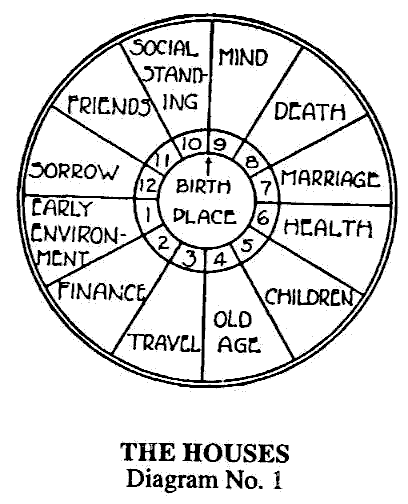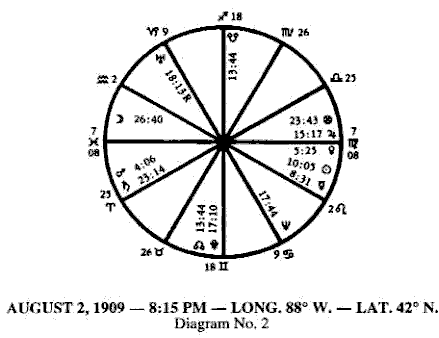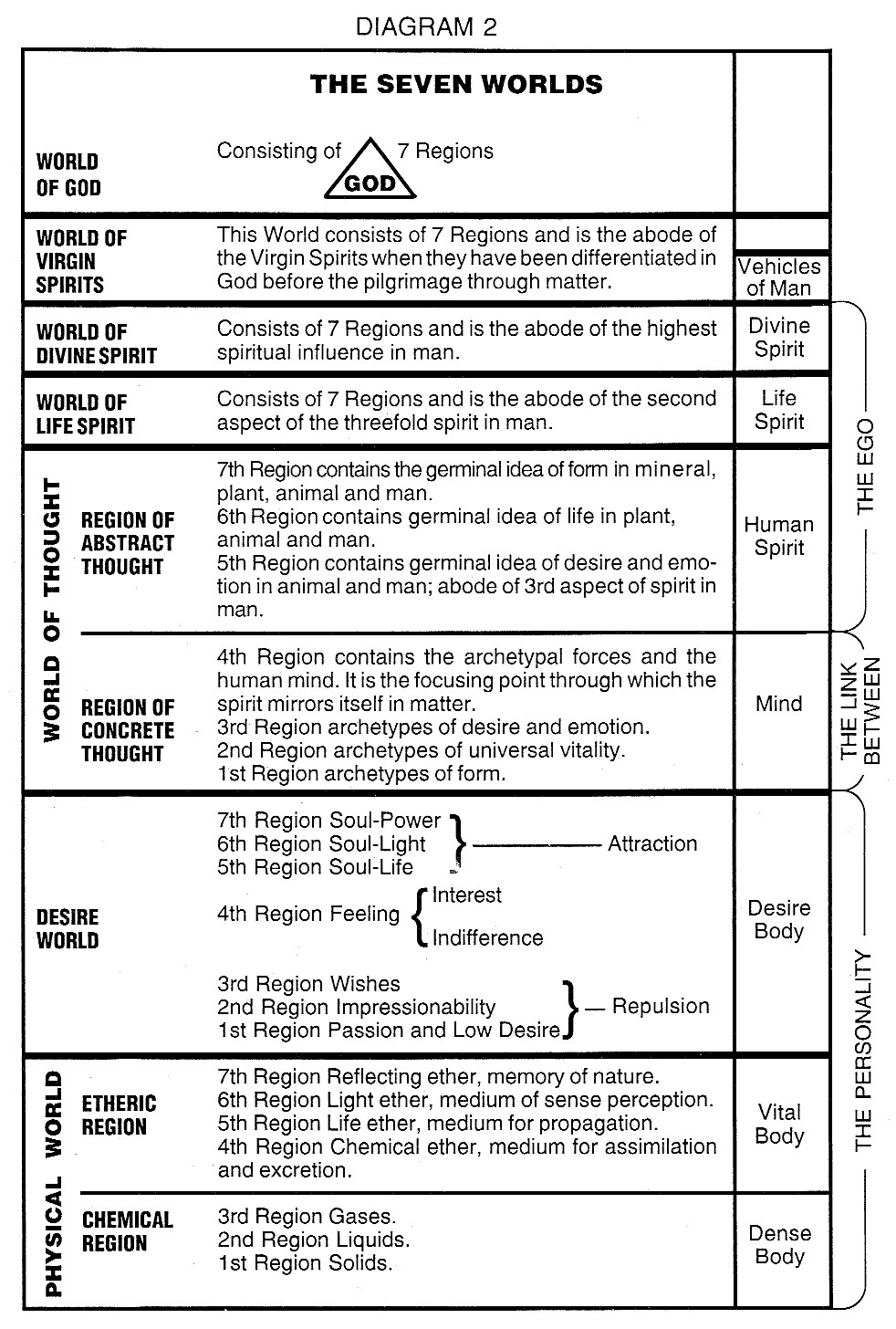
| rosanista.com | ||
| Simplified Scientific Christianity |

Let us consider how the heavens influence our lives through the twelve houses. Suppose we are out driving, and our road follows the seacoast, but a mile or so inland. A breeze is blowing from the ocean and as it passes over the country separating us from the sea, it brings upon invisible wings, messages from that land which evoke pleasure or aversion according to their nature. In one place an aroma of new mown hay fills us with delight; perhaps we are nauseated by the oversweet smell of jasmine on the next stretch of our journey and later become really ill from the stench of stagnant marsh water. But then we enter a forest, and soon its grateful pine balm restores the normal health and spirits.
In our journey from the cradle to the grave we carry the twelve houses with us in the auric atmosphere surrounding each one of us as the air envelops the flying earth. Each house mirrors part of the life; each holds some of our life lessons; each represents how we have worked or shirked before in that department of life's school. At the appropriate time of life we reap from each house what we have sown in past lives — that is, unless we forestall the harvest in time. Is our 11th house afflicted, do friends betray and forsake us, do they leave us heartsick, or nauseate us like the scent of jasmine and stagnant marsh water? Then let us examine the horoscope, for it reveals what is hidden in our auric atmosphere. The friends saw us and we them through the 11th angle, and something ill-smelling must be there. It may be that we long to be befriended more than to befriend others. Let us cease to be like the debilitating jasmine and seek to emulate the sturdy strength of the invigorating pine tree; then we shall find friends flocking around, admiring our strength. Not all have such sturdy natures, but we can attract equally by kindliness, as soothing to sorrowing hearts as perfume of new mown hay to the senses, and thus we may rid the house of friends of affliction.
If you go on your housetop or any other convenient elevation on a clear night, you will see a great many stars adorning the vaulted arch of heaven, and if you look more closely you will observe that they all twinkle — that is to say, with the exception of perhaps one or two which shine with a perfectly steady light. The twinklers are suns of other solar systems so far away that a traveler going with the speed of light would require hundreds of years to reach some of them. They move in such enormous circles and are at such a distance that they appear to maintain the same positions relative to one another. Therefore they are called "fixed stars."
There is a radical difference between the twinklers and the stars which emit a steady light. If you watch one of the latter night after night, you will find that it changes position relative to the fixed stars in a direction from west to east, the same as the Sun. Continued observation of the various heavenly bodies whose light is steady will show that they all follow the same path among the maze of fixed stars. Four such luminous planets are visible to the naked eye at various times of the year. Their names are Saturn, Jupiter, Mars and Venus. A fifth, Mercury, is usually so close to the sun that it is invisible on account of the luminosity of the Sun's rays, but at times it may be seen in the west shortly after sunset or in the east just before sunrise. It twinkles like a fixed star, although it is a planet. There is a spiritual reason for the anomaly, but as that feature would divert our attention, we will pass it by at present.
A telescope is required to properly observe the three planets nearest the outskirts of our solar system, Uranus, Neptune and Pluto.
These eight heavenly bodies move around the Sun. So does the Earth; and the Moon revolves about the Earth; but when we look into space it appears as if the Earth stood still, and Sun, Moon, and planets all move around us. The ancient Ptolemaic system of astronomy in vogue until modern times was based upon this conception of the universe, and subscribed to by all until superseded by the Copernican theory. Skeptics and scoffers who have never taken time nor trouble to investigate, arrogantly maintain that since the Copernican theory has proved that the planets, including the Earth, move around the Sun, that fact in itself is prima facie evidence of the fallacy of astrology, which they term as "exploded superstition."
We do not care to "convince a man against his will," and deem a defense of astrology superfluous, but feel that it may benefit beginners to know the astrologers' views.
When the Sun's rays slant, as they do morning and evening, they give less heat than at noon when they are more nearly perpendicular. Although we are millions of miles nearer the Sun in midwinter than in summer, it is coldest in winter because the Sun's rays are more nearly horizontal then than at any other time of the year. In summer the scorching heat of the perpendicular ray is not lessened because we are then farthest from the Sun. Thus it is evident from observation that the angle of the ray is practically sole determinator of its effect upon the Earth.
Astrology deals also with planetary angles and their observed effects upon humanity. It teaches that varying angles of Sun and planets give different physical, moral, and mental tendencies. The discovery of Copernicus does not render the tabulated statistics of astrologers null and void any more than it eliminates heat from the solar ray. When a certain angle has been established, a corresponding heat is felt today as before the days of Copernicus, and the finer influences dealt with by astrology are not missing, either.
Neither is it an argument against the truth and utility of astrology that predictions sometimes fail. If all came true, it would prove life an unprofitable struggle against inexorable fate and the human will of no avail.
The path pursued by Sun and planets among the fixed stars, year after year, is called the ecliptic, and the fixed stars grouped near this great circle are called the natural zodiac.
In each of the twelve months the Sun appears to travel through a certain group of the zodiacal stars, and therefore they have been divided into twelve natural "signs" of the zodiac. Astrologers also speak of twelve "houses," and it is often a sore puzzle to the beginner to differentiate between these "signs" and "houses," and to understand their relation to one another in the horoscope. We shall therefore try to elucidate the matter as plainly as possible: Procure an orange, apple, or any other soft ball-shaped article, and six long knitting needles. Pierce the ball with them in such a manner that they resemble twelve spokes in a wheel. The ball will then represent the Earth, and the projecting parts of the needles are dividing lines between house and house, each house being located between two needles.
| 1st House: Early Environment | 7th House: Marriage |
| 2nd House: Finance | 8th House: Death |
| 3rd House: Travel | 9th House: Mind |
| 4th House: Old Age | 10th House: Social Standing |
| 5th House: Children | 11th House: Friends |
| 6th House: Health | 12th House: Sorrow |

Now, mark this definition, and you will have no difficulty. The twelve signs are divisions of the heavens relative to the Vernal Equinox and the Ecliptic. The twelve houses are divisions of the heavens relative to the birthplace and the horizon.
The purpose of the division into signs and houses is to determine the angle of the stellar ray, for upon that depends its influence. In order that you may still better understand the principle, drive one of the needles of your wheel into a block of wood so that it stands upright; place it in front of you, and compare it with the illustration in this self-study module which is marked "The Houses." (Diagram No. 1).
The small circles in the diagram correspond to your ball or orange, which represents the Earth moving in space without visible support, and receiving the rays from all the stars and planets scattered over the vault of heaven.

| Midheaven: | Sagitt. 18; Sun: Leo 10:05; Saturn: Aries 23:14 |
| 11th House: | Capricorn 9; Moon: Aquarius 26:40; Uranus: Capricorn 18:13R |
| 12th House: | Aquarius 2; Mercury: Leo 8:31; Neptune: Cancer 17:44 |
| Ascendant: | Pisces 7:08; Venus: Virgo 5:02; Dragon's Head: Gemini 13:44 |
| 2nd House: | Aries 25; Mars: Aries 4:06; Dragon's Tail: Sagitt. 13:44 |
| 3rd House: | Taurus 26; Jupiter: Virgo 15:17; Part of Fortune: Virgo 23:43 |
Let us suppose you are standing on top of the Earth ball, or at the point indicated by the arrow in Diagram No. 1. As you are living in the northern part of the world, you look south when you gaze at the noonday Sun, which is then in its highest elevation, and its ray falls from the angle marked 10 in the diagram. It has been observed that planets which are in that "tenth house" at the birth of a child affect its honor and social standing, and therefore the tenth house is said to "rule" these matters. Planets just rising in the east at birth send their rays through the division marked 1, and have been shown to affect the form of body and conditions of the parental home; hence the "first" house is held to determine these affairs, and so on with all the other houses.
As you know, the Sun appears to travel once around the heavens in a year of 365 days. Mathematicians have made this the basis of their calculations dividing all circles into 360 parts, as it would have been inconvenient to divide by an uneven number like 365. The Sun travels approximately one degree each day, a degree being 1/360th part of a circle.
Each of the twelve signs of the zodiac has exactly 30 degrees and this number of degrees in a sign never varies, making a complete circle of 360 degrees. Houses are also a division of the heaven into twelve parts, but because houses are derived from different reference points than signs they do not always contain 30 zodiacal degrees each. For example in diagram number 2, the 10th house contains 21 zodiacal degrees (counting from 18 to 30 of Sagittarius is 12 degrees, from 0 to 9 of Capricorn is 9 degrees - a total of 21 degrees). The 11th house contains 23 zodiacal degrees (9 to 30 degrees of Capricorn is 21 degrees plus 0 to 2 degrees of Aquarius gives a total of 23 degrees). The deviation of house length from an even 30 degrees becomes more and more pronounced as one moves further north or south of the equator.
In order to understand the next Astrology Independent Study Module, you will require an ephemeris for 1912.
(You are welcome to e-mail your answers and/or comments to us. Please be sure to include the course name and Independent Study Module number in your e-mail to us. Or, you are also welcome to use the answer form below. You will find the answers to the questions below in the next Astrology Independent Study Module.)
1. What is the difference between the signs and the houses?
2. What is the difference between the signs of the zodiac and the planets?
3. What is a degree? How many degrees are there in each sign?
4. How many signs and how many houses are there?
5. What determines the influence of a planet?
6. How many degrees are there from Aries 1 to Taurus 15?
The student should cultivate the spirit of prayer. One of the most legitimate prayers for constant use is:
"O God, increase my love for Thee so that I may serve Thee better from day to day. Let the words of my mouth and the meditation of my heart be acceptable in Thy sight, O Lord, my strength and my Redeemer."
Following St. Paul's instructions, pray without ceasing.
If this prayer is used regularly, it will unfold your consciousness scientifically and spiritually.
— Fellow Students of Contemporary Mystic Christianity
1. Longitude is the distance East or West of Greenwich; Latitude is the distance North or South of the Equator.
2.
| Berlin, W. Germany: | Lat. 52 N | Long. 13 E |
| Vienna, Austria: | 48 N | 16 E |
| Baghdad, Iraq: | 33 N | 44 E |
| Santiago, Chile: | 33 S | 71 W |
| Ottawa, Canada: | 45 N | 76 W |
| Detroit, Michigan, U.S.A: | 42 N | 83 W |
| Los Angeles, California, U.S.A: | 34 N | 118 W |
| Vancouver, Canada: | 49 N | 123 W |
3. Birth occurs from the astrological viewpoint with the first breath or cry of the infant.
4. The stellar forces that exist at the moment when the child utters its first cry are drawn into the lungs and pass through the blood. The impressions of these forces are stamped on every atom of the child's body, and they prevail throughout the entire life.
5. The purpose of astrology is to teach that the stellar forces exist, so that by our wills we may regulate our lives advantageously and help others to do the same.
6. The twelve signs of the zodiac and their symbols are:


|

|

|
|
|
Contemporary Mystic Christianity |
|
|
This web page has been edited and/or excerpted from reference material, has been modified from its original version, and is in conformance with the web host's Members Terms & Conditions. This website is offered to the public by students of The Rosicrucian Teachings, and has no official affiliation with any organization. | Mobile Version | |
|